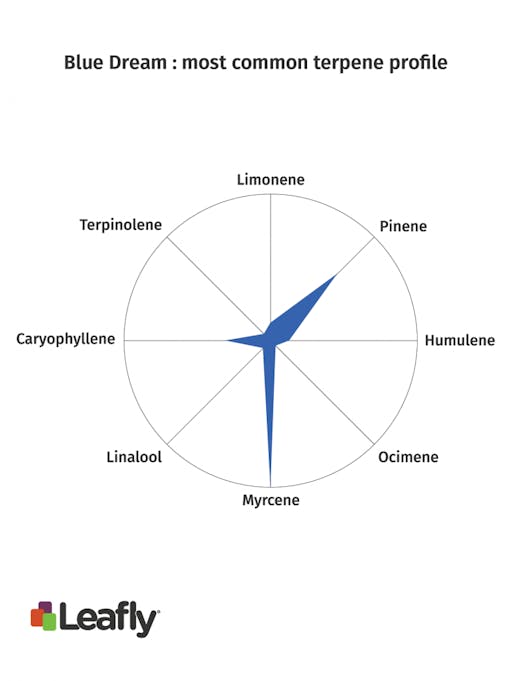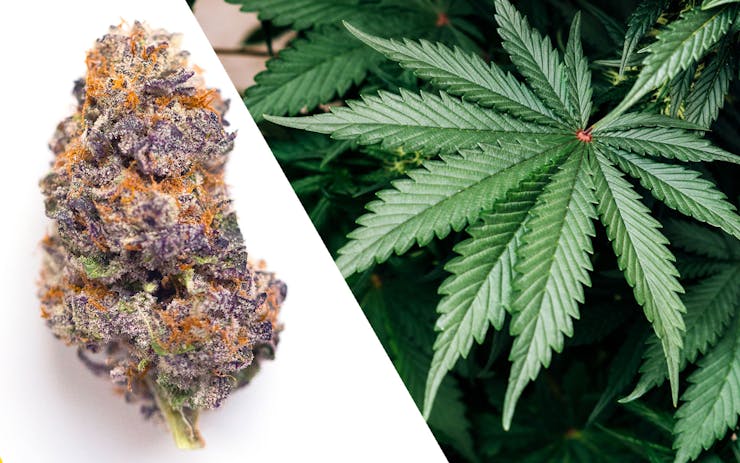Cannabis strains are made up of cannabinoids (like THC and CBD) as well as terpenes, which are aromatic compounds that give each flower its unique aroma. We’re constantly learning more about these terpenes and how they impact the overall experience of consuming cannabis.
When choosing a strain, we often think of sativas and indicas as being polar opposites in effect, but if you look closely at their chemical composition—again, cannabinoids and terpenes—you’ll notice that many indica- and sativa-dominant strains are unexpectedly similar, chemically speaking. Let’s get into some of these unanticipated similar pairs.
Blue Dream and 9 Pound Hammer


Primary terpenes:Myrcene, pinene, caryophyllene
Cannabinoid content: Blue Dream (19% THC on average), 9 Pound Hammer (18% THC on average)
With a reputation as a daytime strain for beginners, it’s pretty interesting to see the chemical similarities between the famed Blue Dream and the powerful 9 Pound Hammer, a strain that is more commonly chosen as a nighttime smoke. Terpene-wise, you’ll see that they are both dominant in myrcene, pinene, and caryophyllene, and tend to hold little difference in THC percentages on average.
So why do people perceive these as such different strains?
On average, Blue Dream has more pinene, which some say has alerting qualities (although science has yet to prove this effect in cannabis). This and a harmony of other minor terpenes and cannabinoids could explain why Blue Dream feels lighter than 9 Pound Hammer. Also, when consumed in copious amounts, Blue Dream can feel very relaxing and somewhat sedative, narrowing the gap between these two strains further.
Shop highly rated dispensaries near you
Showing you dispensaries nearCinex and Purple Hindu Kush


Primary terpenes:Limonene, caryophyllene, pinene
Cannabinoid content: Cinex (16% THC on average), Purple Hindu Kush (20% THC on average)
This one is the most fascinating of the bunch; there’s truly nothing sedative, sleepy, or any other words you’d use to describe “purple weed” like Purple Hindu Kush about Cinex. But here they are with essentially the same terpene profile. Both strains come packed with THC and are dominant in limonene, caryophyllene, and pinene terpenes. However, most people swear they feel so different.
A cross between Cindy 99 and Vortex, Cinex is known to be an uplifting strain with energetic qualities that send the brain into a powerful creative zone, as well as help you wash your stresses down the drain. I’ve consumed it multiple times and it never puts me to sleep or even in a “down” type of energy.
A combination of two powerhouses, Hindu Kush and Purple Afghani, Purple Hindu Kush provides a heavily relaxing experience, which is why some consumers with chronic pain reach for this strain. This is one of those potent strains that’ll put most people on their ass for hours.
These two strains are another great example of how cannabinoids combine with terpenes to produce effects. Cinex and Purple Hindu Kush are very similar terpene-wise, but maybe PHK’s tendency to produce higher levels of THC on average helps explain why this strain delivers a sock-it-to-me type of high.
Chernobyl and Golden Lemon


Primary terpenes:Terpinolene, myrcene, caryophyllene
Cannabinoid content: Chernobyl (18% THC on average), Golden Lemon (23% THC on average)
Chernobyl is a citrus-flavored cross of Trainwreck, Jack The Ripper, and Trinity. With its long-lasting cerebral high and mood-lifting qualities, many associate Chernobyl with daytime activities. So it’s mildly surprising to see that its terpene profile is very similar to Golden Lemon, an indica-dominant hybrid cross of Kosher Kush and Lemon Skunk that many seek for its relaxing qualities.
Though often differing in perceived effects, the common terpene profile produces pungent citrus flavors in both strains. This is a great example of how cannabinoids play an equal role in the entourage effect of cannabinoids and terps that our body feels. Sure, these strains may smell and taste similar—but the higher-on-average THC levels in Golden Lemon may help push its potency towards more sedative relaxation.





